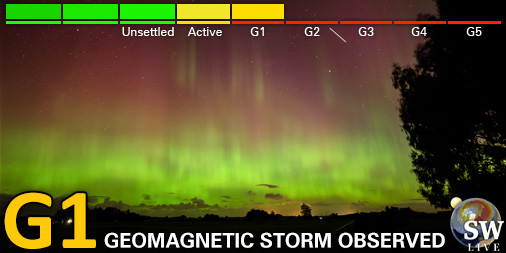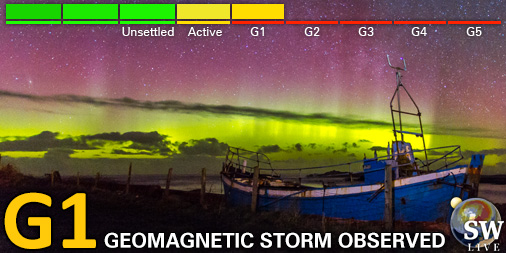Het archief bekijken van dinsdag 17 juni 2003
Activiteitenrapport
Bij elke genoemde zonnevlam in dit rapport werd een schaalfactor toegepast door het Space Weather Prediction Center (SWPC). Vanwege de SWPC-schaalfactor worden zonnevlammen 42% kleiner gerapporteerd dan voor de wetenschappelijke data. De schaalfactor werd verwijderd uit onze gearchiveerde zonnevlamdata om de werkelijke fysieke eenheden weer te geven.
Rapport van de zonne- en geofysische activiteit van 2003 Jun 17 2200 UTCOpgemaakt door de NOAA © SWPC en verwerkt door Poollicht.be
USAF/NOAA rapport van de zonneactiviteit en geofysische activiteit
SDF Nummer 168 gepubliceerd omstreeks 2200Z op 17 Jun 2003IA. Analyse van de actieve zonneregio's en zonneactiviteit van 16-2100Z tot 17-2100Z
Solar activity was at low levels. The largest flare
was a C2 flare at 0222 UTC from Region 386 (S07E58). This region
continues to increase in area coverage as it rotates further onto
the visible disk. Magnetic analysis indicates a beta-gamma
magnetic configuration. Region 380 (S15W64) continues a its gradual
decay in area and now has a beta magnetic configuration.
IB. Voorspelling zonneactiviteit
Solar activity is expected to be at
low to moderate levels with a chance of isolated high level
activity. Region 386 has the potential for major flare activity.
IIA. Samenvatting geofysische activiteit 16-2100Z tot 17-2100Z
The geomagnetic field was at active to major storm levels. A
six-hour period of southward Bz, from 06 - 09 UTC combined with
elevated solar wind speed near 510 km/s produced minor and major
storm levels.
IIB. Voorspelling geofysische activiteit
The geomagnetic field is
expected to be at unsettled to minor storm levels. A weak CME shock
is possible late on day one with isolated minor storm levels
possible. High speed stream effects are expected on day two and day
three with minor storm levels possible.
III. Kans zonnevlammen van 18 Jun tot 20 Jun
| Klasse M | 40% | 40% | 40% |
| Klasse X | 20% | 20% | 20% |
| Proton | 30% | 20% | 20% |
| PCAF | green | ||
IV. Penticton 10.7 cm Flux
Geobserveerd 17 Jun 122 Voorspeld 18 Jun-20 Jun 125/120/120 90 dagen gemiddelde 17 Jun 125
V. Geomagnetische A index
Geobserveerd Afr/Ap 16 Jun 020/032 Geraamd Afr/Ap 17 Jun 040/050 Voorspeld Afr/Ap 18 Jun-20 Jun 020/030-020/030-020/025
VI. Kansen op geomagnetische activiteit van 18 Jun tot 20 Jun
| A. Gemiddelde breedtegraad | |||
|---|---|---|---|
| Actief | 35% | 40% | 40% |
| Kleine storm | 15% | 20% | 20% |
| Zware-ernstige stormcondities | 05% | 05% | 05% |
| B. Hoge breedtegraad | |||
|---|---|---|---|
| Actief | 40% | 50% | 50% |
| Kleine storm | 20% | 25% | 25% |
| Zware-ernstige stormcondities | 10% | 15% | 15% |
Alle tijden in UTC
<< Keer terug naar de dagelijkse overview pagina
Op basis van de huidige parameters is er nu geen kans op poollicht in België en Nederland
Laatste nieuws
Laatste forumberichten
Suggesties? 8Noorderlicht kans 6-1-2025 2Poollicht 1 januari 2025 2Naar Noorwegen in Maart? 3Noorderlicht kans 10/11-10-2024 56
Meer forumberichtenSteun Poollicht.be!
Om ook bereikbaar te blijven bij grote poollichtkansen hebben we een zware server nodig die alle bezoekers aankan. Doneer en steun dit project zodat we online blijven en je geen enkele poollichtkans mist!

Laatste alerts
15:09 UTC - Hemisferisch vermogen
Het OVATION-model voorspelt dat het hemisferisch vermogen 50GW zal bereiken om 15:48 UTC
08:00 UTC - Geomagnetische activiteit
G1 - Kleine geomagnetische storm (Kp5) Drempel bereikt: 07:52 UTC
zaterdag 3 mei 2025
10:45 UTC - Geomagnetische activiteit
G1 - Kleine geomagnetische storm (Kp5) Drempel bereikt: 10:30 UTC
08:57 UTC - Hemisferisch vermogen
Het OVATION-model voorspelt dat het hemisferisch vermogen 76GW zal bereiken om 09:32 UTC
01:00 UTC - Geomagnetische activiteit
G1 - Kleine geomagnetische storm (Kp5) Drempel bereikt: 00:55 UTC
Ruimteweer feitjes
| Laatste X-klasse uitbarsting | 28/03/2025 | X1.1 |
| Laatste M-klasse uitbarsting | 30/04/2025 | M2.03 |
| Laatste geomagnetische storm | 03/05/2025 | Kp5 (G1) |
| Zonnevlekkenloze dagen | |
|---|---|
| Laatste zonnevlekkenloze dag | 08/06/2022 |
| Maandelijks gemiddeld zonnevlekkengetal | |
|---|---|
| april 2025 | 140.6 +6.4 |
| mei 2025 | 58 -82.6 |
| Afgelopen 30 dagen | 114 -17.5 |





